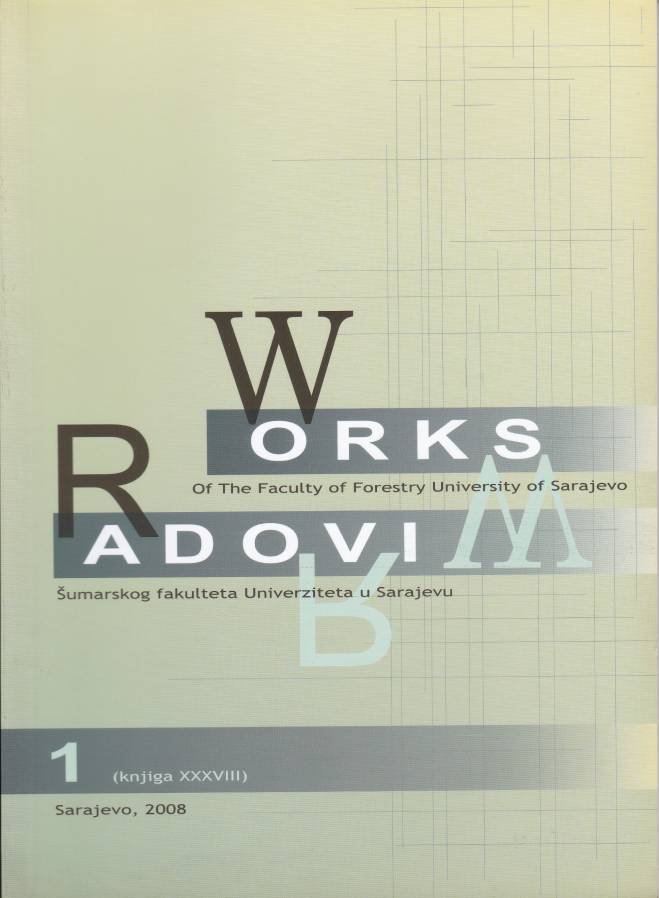Risogenesis Induction of Black currant (Ribes nigrum L.)
DOI:
https://doi.org/10.54652/rsf.2008.v38.i1.174Keywords:
Ribes nigrum L, plant hormones, root, affected cutting, cuttings, rizogenesisAbstract
UDK 631.535: 634.723
634.723:577.175.1
Black currant (Ribes nigrum L.) is the species with the common usage in the horticulture in different ways due to its significant decoration attributes, as self- contained bush or as a hedge. Because of its quality and nutritious fruits, black currant is often raised in gardens as berry fruits.
This study elaborates rizogenesis of black currant, and it implies the possibility of mass production by means of vegetative reproduction, with usage of ripe cuttings. Furthermore, it showed influence of the affected cuttings and different hormonal treatments on the risogenesis induction, on a number of cuttings and on the quality of the root system (length and thickness of the lateral roots and the number of second line roots).
The cuttings were treated with three types of plant hormones (IAA, IBA, and NAA) in a mould form, in addition to the control group, without hormonal treatment.
In this study, the total sample was 110 cuttings, with 55 affected cuttings (sharpened 1,5 cm above the base of cuttings), and 55 cuttings without harm. Therefore, 30 cuttings (15 with and 15 without harm) were treated with hormones, and 20 cuttings (10 with and 10 without harm) were used as a control group, without hormonal treatment.
The cuttings were raised in containers with the mixture substrate of sphagnum and sand, in 3:1 ratio.
After 3 months, the cuttings were pulled out from the mixture substrate and measurements were done. The arithmetic mean value of the length of the lateral roots was the highest in the group with IAA hormonal treatment (7,251 cm for affected cuttings), and the lowest value was in the group with NAA hormonal treatment (4,019 cm no affected cuttings).
The highest arithmetic mean value for the thickness of lateral roots was in the group with NAA hormonal treatment (0,793 mm for affected cuttings), and the lowest value was in the control group (non-affected cuttings: 0,272 mm).
The arithmetic mean value for the number of roots, at the second line of roots, was noticed at the affected cuttings with IAA hormonal treatment (26,661 roots), while the smallest number was in the non-affected control group of cuttings (7,252 roots per individual).
From the denominated results, the best hormonal treatment for risogenesis induction of black currant was with IAA for the affected cuttings, which coincides with the available sources reported by other researchers.
Downloads
References
GRBIĆ, M. (2004): Vegetativno razmnožavanje ukrasnog drveća i žbunja, Beograd.
HESSAYON, D.G. (2001): Cvatući grmovi, Mozaik knjiga, Zagreb.
JOVANOVIĆ, B. (2000): Dendrologija, Univerzitetska štampa, Beograd.
KURTOVIĆ, M., GAŠI, F., DRKENDA, P., HADŽIABULIĆ, S. (2003): Jagodasto voće Prozor-
Rama: Natura Ramae, Sarajevo.
LJUJIĆ-MIJATOVIĆ, T., MRDOVIĆ, A. (1998): Proizvodnja cvijeća i ukrasnog bilja, Univerzitet u Sarajevu, Sarajevo
MEĐEDOVIĆ, S. (1987): Ožiljavanje reznica smrče u cilju razvijanja tehnologije masovne proizvodnje sadnica, Šumarstvo i prerada drveta, Sarajevo. 1-3: 27 – 33.
MEĐEDOVIĆ, S., FERHATOVIĆ, DŽ. (2003): Klonska proizvodnja sadnica drveća i grmlja, BEMUST, Sarajevo.
MEKIĆ, F. (1998): Uzgajanje i umnožavanje drveća i grmlja, Šumarski fakultet, Sarajevo.






















